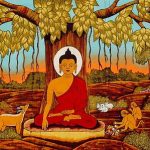 “What I have revealed is: ‘This is Suffering, this is the Arising of Suffering, this is the Cessation of Suffering, and this is the Path that leads to the Cessation of Suffering.’ And why, [monks], have I revealed it? Because this is related to the goal, fundamental to the holy life, conduces to disenchantment, dispassion, cessation, tranquillity, higher knowledge, enlightenment and Nibbaana [cessation], therefore I have revealed it. Therefore, [monks], your task is to learn: ‘This is Suffering, this is the Arising of Suffering, this is the Cessation of Suffering, this is the Path that leads to the Cessation of Suffering.’ That is your task.” — Buddha, Simsapa Sutra, SN 56:31
“What I have revealed is: ‘This is Suffering, this is the Arising of Suffering, this is the Cessation of Suffering, and this is the Path that leads to the Cessation of Suffering.’ And why, [monks], have I revealed it? Because this is related to the goal, fundamental to the holy life, conduces to disenchantment, dispassion, cessation, tranquillity, higher knowledge, enlightenment and Nibbaana [cessation], therefore I have revealed it. Therefore, [monks], your task is to learn: ‘This is Suffering, this is the Arising of Suffering, this is the Cessation of Suffering, this is the Path that leads to the Cessation of Suffering.’ That is your task.” — Buddha, Simsapa Sutra, SN 56:31
Our primary point of study as practitioners of the Buddha Way is the mind itself. After all, the Buddha realized the nature of suffering and the path to the end of suffering not in libraries, but by sitting still outside under a bodhi tree — calming his body and studying the mind.
Over the centuries following the Buddha’s passing, his teachings and commentaries of them were preserved in written form. The wide collection of texts unfolds from the earliest Tipitaka (Pali Canon) notable in the Theravada School to the Prajana Paramita sutras in the Mahayana School to the records of ancient Zen Masters such as, Bodhidharma, Huineng and Linji, and leading right up to the White Lotus Haven Zen lineage Masters of our present time.
These written teachings, which are part of a WLHZ student’s collection, are useful in helping point to experiences of practice and enlightenment. Ultimately, however, it is up to each person to study their own mind, as the Buddha did, in order to realize liberation from suffering for themselves.
“To study the Buddha Way is to study the self. To study the self is to forget the self. To forget the self is to be actualized by myriad things. When actualized by myriad things, your body and mind as well as the bodies and minds of others drop away. No trace of enlightenment remains, and this no-trace continues endlessly.”
― Master
